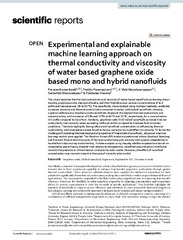| dc.contributor.author | Kanti, Praveen Kumar | |
| dc.contributor.author | Paramasivam, Prabhu | |
| dc.contributor.author | Wanatasanappan, V. Vicki | |
| dc.contributor.author | Dhanasekaran, Seshathiri | |
| dc.contributor.author | Sharma, Prabhakar | |
| dc.date.accessioned | 2025-01-17T11:19:10Z | |
| dc.date.available | 2025-01-17T11:19:10Z | |
| dc.date.issued | 2024-12-28 | |
| dc.description.abstract | This study explores the thermal conductivity and viscosity of water-based nanofluids containing silicon
dioxide, graphene oxide, titanium dioxide, and their hybrids across various concentrations (0 to 1
vol%) and temperatures (30 to 60 °C). The nanofluids, characterized using multiple methods, exhibited
increased viscosity and thermal conductivity compared to water, with hybrid nanofluids showing
superior performance. Graphene oxide nanofluids displayed the highest thermal conductivity and
viscosity ratios, with increases of 52% and 177% at 60 °C and 30 °C, respectively, for a concentration
of 1 vol% compared to base fluid. Similarly, graphene oxide-TiO2 hybrid nanofluids achieved thermal
conductivity and viscosity ratios exceeding 43% and 144% compared to the base fluid at similar
conditions. This data highlights the significance of nanofluid concentration in influencing thermal
conductivity, while temperature was found to have a more pronounced effect on viscosity. To tackle the
challenge of modeling the thermophysical properties of these hybrid nanofluids, advanced machine
learning models were applied. The Random Forest (RF) model outperformed others (Gradient Boosting
and Decision Tree) in both the cases of thermal conductivity and viscosity with greater adaptability to
handle fresh data during model testing. Further analysis using shapely additive explanations based on
cooperative game theory revealed that relative to temperature, nanofluid concentration contributes
more to the predictions of the thermal conductivity ratio model. However, the effect of nanofluid
concentration was more dominant in the case of viscosity ratio model. | en_US |
| dc.identifier.citation | Kanti, Paramasivam, Wanatasanappan, Dhanasekaran, Sharma. Experimental and explainable machine learning approach on thermal conductivity and viscosity of water based graphene oxide based mono and hybrid nanofluids. Scientific Reports. 2024;14(1) | en_US |
| dc.identifier.cristinID | FRIDAID 2341507 | |
| dc.identifier.doi | 10.1038/s41598-024-81955-1 | |
| dc.identifier.issn | 2045-2322 | |
| dc.identifier.uri | https://hdl.handle.net/10037/36218 | |
| dc.language.iso | eng | en_US |
| dc.publisher | Springer Nature | en_US |
| dc.relation.journal | Scientific Reports | |
| dc.rights.accessRights | openAccess | en_US |
| dc.rights.holder | Copyright 2024 The Author(s) | en_US |
| dc.rights.uri | https://creativecommons.org/licenses/by/4.0 | en_US |
| dc.rights | Attribution 4.0 International (CC BY 4.0) | en_US |
| dc.title | Experimental and explainable machine learning approach on thermal conductivity and viscosity of water based graphene oxide based mono and hybrid nanofluids | en_US |
| dc.type.version | publishedVersion | en_US |
| dc.type | Journal article | en_US |
| dc.type | Tidsskriftartikkel | en_US |
| dc.type | Peer reviewed | en_US |


 English
English norsk
norsk
